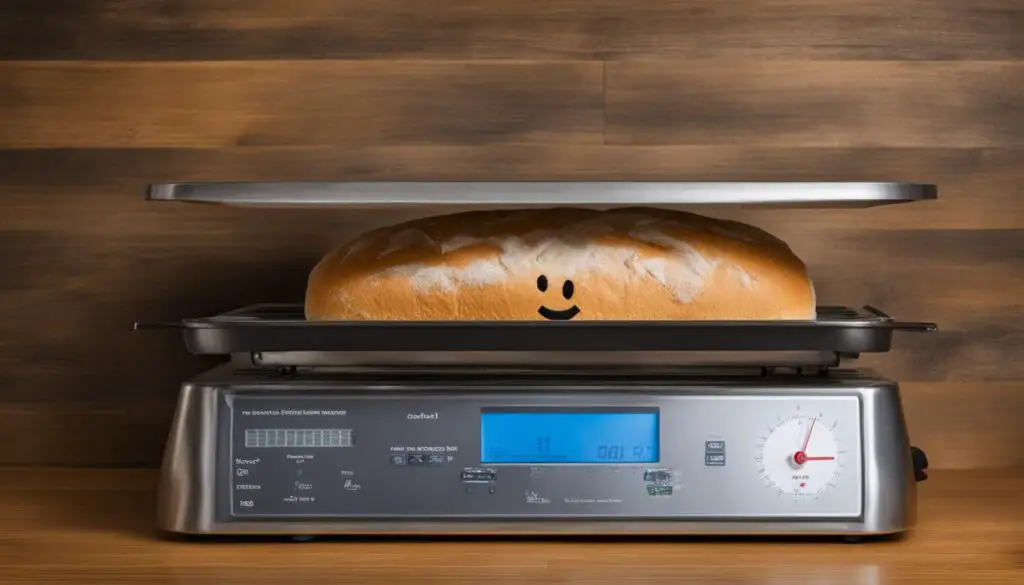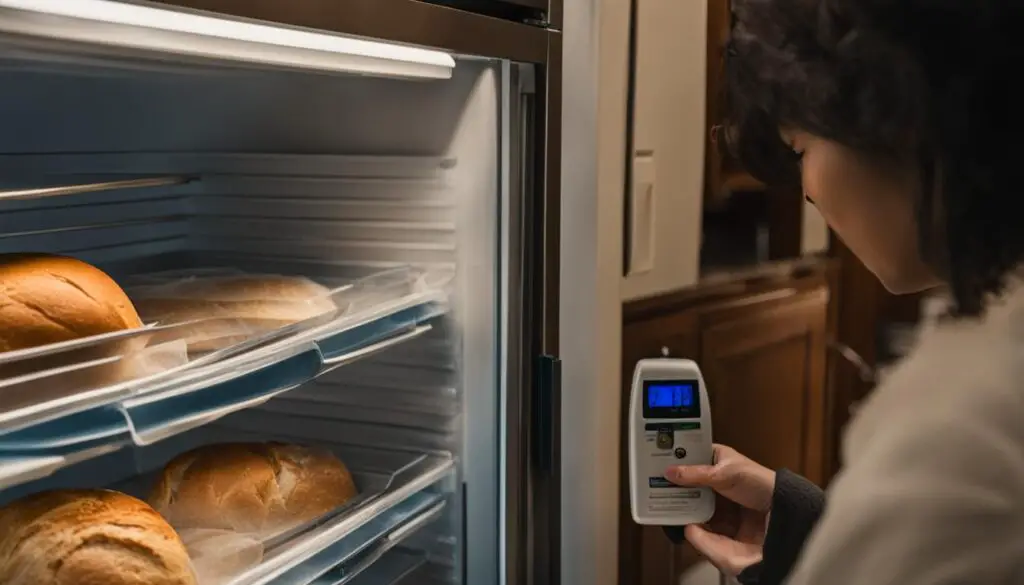Have you ever wondered if it’s safe to refreeze bread after thawing it out? Perhaps you accidentally left your loaf of bread out overnight and now you’re unsure if it’s safe to refreeze it. In this section, we will explore whether you can refreeze bread and address common questions about refreezing bread.
It’s important to understand that bread can go bad quickly, especially if it is not properly stored. Refreezing bread can pose some safety concerns if it is not done correctly, such as the risk of bacterial growth or loss of quality and texture.
So, can you refreeze bread that has defrosted? The answer is yes, but there are some important considerations to keep in mind.
In the following sections, we will dive into the science behind refreezing bread, provide best practices for refreezing, and explore alternative solutions for using frozen bread.
Key Takeaways
- Refreezing bread can be done safely, but the proper precautions must be taken.
- Bread can lose quality and texture when refrozen, so best practices must be followed for optimal results.
- It is important to understand the risks associated with refreezing bread that has defrosted.
- If done correctly, refreezing bread can be a practical solution for reducing food waste.
- Alternative solutions for using frozen bread include repurposing it in recipes or preparing it in specific ways.
Understanding the Science Behind Refreezing Bread
When it comes to refreezing bread, understanding the science behind it can help you achieve the best results. Bread contains starch and water molecules that interact during freezing and can lead to changes in the texture and taste of the bread.
When bread is frozen and thawed, ice crystals form and melt, causing the bread to lose moisture. This can result in a dry and crumbly texture. Additionally, the process of freezing and thawing can break down the gluten in the bread, which can affect its volume and structure.
To refreeze bread without compromising its taste and texture, it’s important to take the proper steps. First and foremost, make sure the bread is properly wrapped or sealed to prevent freezer burn. This can be done by using airtight containers, freezer bags, or aluminum foil.
When it comes to refreezing bread, it’s best to do so as soon as possible after it has been thawed. This helps to minimize the changes in texture and taste. For best results, try to refreeze bread only once and avoid freezing bread that has already been frozen and thawed multiple times.
Tip: If you plan on refreezing bread, it’s best to slice it beforehand, as this can help to preserve its texture and make it easier to defrost in the future.
Another way to maintain the quality of refrozen bread is to wrap it in aluminum foil and place it in a preheated oven at 350°F for 10 to 15 minutes. This can help to restore the texture and crust of the bread.
Best Practices to Refreeze Bread
Here are some best practices to refreeze bread without compromising its taste and texture:
- Wrap the bread tightly in plastic wrap or aluminum foil
- Label the bread with the date it was first frozen
- Try to refreeze bread only once
- Slice the bread before refreezing
- Defrost the bread in the refrigerator overnight
- Reheat the bread in the oven to restore its texture
By following these best practices, you can ensure that your refrozen bread tastes just as fresh as it did before it was frozen.

The Do’s and Don’ts of Refreezing Bread
Refreezing bread can be a tricky process, and it’s important to follow some basic guidelines to ensure that the bread remains safe to eat and maintains its texture and flavor. Here are some do’s and don’ts to keep in mind:
Do: Thaw Bread Properly
To maintain the quality of bread, it’s important to thaw it properly. You can thaw bread at room temperature, but avoid leaving it out for too long as this can encourage bacterial growth. Alternatively, you can thaw bread in the fridge overnight. If you thaw bread in the microwave, make sure to use the defrost setting and monitor it closely to avoid overheating.
Don’t: Refreeze Bread More Than Once
It’s best to refreeze bread only once after it has been thawed. Refreezing bread multiple times can lead to a loss of quality, as the freezing and thawing process can break down the bread’s texture and flavor.
Do: Use High-Quality Freezer Bags or Containers
When freezing bread, it’s important to use high-quality freezer bags or containers to prevent freezer burn and maintain the bread’s flavor and texture. Make sure to squeeze out any excess air before sealing the bag or container to prevent ice crystals from forming.
Don’t: Refreeze Bread That Has Been Left at Room Temperature for Too Long
If you’ve left bread out at room temperature for an extended period, it’s best to avoid refreezing it. Bacteria can grow quickly at room temperature, and refreezing bread that has been left out for too long can lead to foodborne illness.
Do: Label Freezer Bags or Containers With the Date
When freezing bread, it’s important to label the freezer bags or containers with the date to keep track of how long the bread has been frozen. This can help you avoid refreezing bread that has been in the freezer for too long and ensure that you’re using the bread before it loses quality.
Don’t: Refreeze Bread That Has Been Thawed and Left in the Fridge for More Than a Few Days
If you’ve thawed bread in the fridge, it’s best to use it within a few days to prevent bacterial growth. Refreezing bread that has been thawed and left in the fridge for too long can lead to a loss of quality and potential food safety issues.

By following these guidelines, you can safely refreeze bread without compromising its quality or safety. Remember to thaw bread properly, only refreeze it once, use high-quality freezer bags or containers, label them with the date, and avoid refreezing bread that has been at room temperature or in the fridge for too long.
Exploring Alternative Solutions for Frozen Bread
When it comes to properly handling frozen bread, there are a variety of alternative solutions to consider beyond simply refreezing it. Depending on the type of bread, there are different ways to repurpose it and make the most out of your frozen loaves. Here are some suggestions:
Banana Bread
Banana bread is a popular and delicious treat, but can also be challenging to store correctly. If you have leftover banana bread that has been frozen and thawed, it is not recommended to refreeze it. Instead, try toasting the bread and adding a spread of butter or peanut butter for a tasty snack.
Ezekiel Bread
Ezekiel bread is a nutritious and hearty option, with a unique nutty flavor. If you find yourself with leftover Ezekiel bread that has been frozen, it can be safely refrozen. However, it may lose some of its texture and taste. Alternatively, try using it in a breakfast casserole or as a base for a veggie sandwich.
Rolls
If you have leftover rolls that have been frozen, they can be safely refrozen. However, if you’re looking for a more creative way to use them, consider making mini slider sandwiches or using them as a base for bread pudding.
Bagels
Like rolls, bagels can be safely refrozen but may lose some of their texture. For a fun twist, try slicing and toasting them for bagel chips, or use them as a base for homemade pizza.
Rye Bread
Rye bread is a denser bread with a bold flavor that pairs well with savory dishes. If you have leftover rye bread that has been frozen, it can be safely refrozen. Alternatively, try using it in a savory bread pudding or as a base for a Reuben sandwich.
Bread Dough After the Second Rise
If you have extra bread dough that you’ve let rise a second time but don’t want to bake just yet, it can be safely frozen. Wrap it tightly in plastic wrap and store in the freezer. When you’re ready to use it, thaw it in the refrigerator overnight, then let it come to room temperature before baking.
In conclusion, while refreezing bread is possible, it may not always result in the best quality. Instead of refreezing, consider utilizing frozen bread in alternative ways, like toasting it or using it in unique recipes.

Conclusion
In conclusion, refreezing bread can be done effectively if proper guidelines are followed. It is important to remember that refreezing bread too many times can compromise its quality, taste, and texture. To ensure the best results, it is recommended to freeze bread immediately after purchase or within a few days of baking. When refreezing, double wrapping and removing excess air can help maintain the bread’s freshness and taste.
It is also important to note that not all types of bread can be refrozen effectively. Some bread, such as banana bread, may not hold up as well after being frozen. Additionally, bread dough should not be refrozen after the second rise.
By following the recommendations in this article and using common sense, readers can enjoy their bread without fear of compromising its quality. Remember, proper storage and handling can make all the difference in enjoying delicious, refrozen bread.
FAQ
Can you refreeze bread effectively?
Yes, you can refreeze bread effectively. However, there are some important considerations to keep in mind to ensure the quality and safety of the bread.
What happens when bread is refrozen?
When bread is refrozen, the moisture in the bread can crystallize, leading to a change in texture and potentially affecting the taste. It is important to take proper steps to minimize these changes.
Is it safe to refreeze bread after thawing?
Yes, it is safe to refreeze bread after it has been thawed. However, it is crucial to handle the bread properly during the thawing and refreezing process to maintain its quality and prevent bacterial growth.
Can you refreeze bread that has defrosted?
Yes, you can refreeze bread that has defrosted. However, it is essential to handle the bread properly and ensure it has been stored at the proper temperature to maintain its quality and safety.
What are the best practices to refreeze bread effectively?
To refreeze bread effectively, it is recommended to slice the loaf or separate it into portions before freezing. This allows for easier thawing and minimizes the potential for moisture loss. It is also important to wrap the bread tightly in plastic wrap or place it in airtight containers to prevent freezer burn.
Can you thaw and refreeze bread?
Yes, you can thaw and refreeze bread. However, it is crucial to handle the bread properly during the thawing process to minimize the risk of bacterial growth and follow the best practices for refreezing.
Can you freeze bread multiple times?
It is generally not recommended to freeze bread multiple times. Each time bread is frozen and thawed, its quality can deteriorate further. It is best to freeze bread once and consume it within a reasonable time frame.
What should I do if bread has defrosted?
If bread has defrosted, it is important to inspect it for any signs of spoilage, such as mold or an off odor. If the bread appears and smells fine, it can be reheated or used immediately. However, if there are any concerns about its safety, it is best to discard the bread.
What can I do with frozen bread?
There are several options for using frozen bread. You can toast it, make sandwiches, or use it in various recipes, such as bread pudding or croutons. Frozen bread can also be used for making breadcrumbs or as a base for garlic bread.
Can specific types of bread be refrozen?
Specific types of bread, such as banana bread, ezekiel bread, rolls, bagels, or rye bread, can be refrozen. However, it is important to ensure they have been properly stored and handled to maintain their quality.
Can bread dough be refrozen after the second rise?
It is not recommended to refreeze bread dough after the second rise. This can affect the yeast activity and result in poor texture and taste. It is best to bake the bread and then freeze any leftovers.






